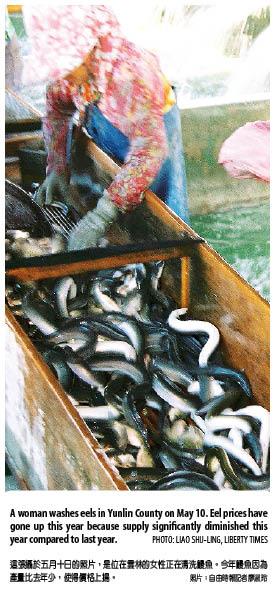Eels are at their plumpest and prettiest from May to September every year. More than 80 percent of Taiwan’s eel is exported to Japan. Even though Japan survived the earthquake and tsunami that ravaged the country’s east coast on March 11, their demand for eel has not diminished, which is causing eel prices in Taiwan to soar. Eel is currently traded at more than NT$900 per kilogram, breaking a half-century record. Local businesses have already stealthily raised the price of unadon, a popular dish of grilled eel over a bed of rice, by NT$40 to NT$70 per portion.
An official at the Fisheries Agency said that climate change has caused the number of natural elvers to decrease, leaving production this year at a mere 2,000 tons, barely half of last year’s production of 4,000 to 5,000 tons. Summer is a time when Japanese consume the most eel, which is believed to be a health supplement, thus, export quantity also influences local prices. A gift box containing four eels is currently sold at around NT$1,000 per box, a NT$200 to NT$300 increase from previous prices.
One kilogram, or about four to six eels, is sold at as much as NT$920. However, the eel market is still proving profitable even though supply is unable to meet demand. The president of an eel cooperative in Yunlin County said the price per kilogram used to be under NT$700, but is expected to rise beyond NT$1,000 by the end of May, which means consumers will have to shovel out more money if they still wish to enjoy fresh eel.

Photo: Liao Shu-ling, Liberty Times
照片:自由時報記者廖淑玲
One owner of a Japanese restaurant said she usually launches a special eel-based menu every year in June, but that she has yet to settle on her prices this year because she must refer to June eel prices to make her final decision. If one kilogram of eel exceeds NT$1,000, she will have to compromise with a price hike. The owner of an unadon restaurant in Greater Taichung said he already adjusted his prices on May 1 as a reaction to the cost of eel. Small portions were raised from NT$140 to NT$180 while big portions are now sold for NT$350, originally only NT$280.
However, some business owners are choosing to limit the quantity of eel they serve instead of raising prices. One restaurant in Taipei is planning to reduce the amount of eel served in each portion so that every customer will still get a chance to enjoy their eel. They will also encourage customers to order other dishes to reduce the consumption of eel in their shop. On the other hand, a restaurant in Kaohsiung has opted to reduce the portions of unadon, the most popular dish they offer, to only 50 per day. The owner said if prices keep soaring he will be forced to raise his prices as well.
(LIBERTY TIMES, TRANSALTED BY TAIJING WU)
每年五月至九月是鰻魚最肥美的季節,八成以上的台灣鰻魚都外銷日本。即使日本遭強震蹂躪,對鰻魚需求仍未縮減,造成台灣鰻魚價格飆漲。目前每公斤漲破九百元,打破銷日五十年來的紀錄。坊間業者有人已將鰻魚飯價格悄悄調漲了四十元至七十元。

Photo: Liao Shu-ling, Liberty Times
照片:自由時報記者廖淑玲
漁業署官員表示,由於受到天候影響,天然鰻苗減少,導致今年的鰻魚產量目前僅剩下二千公噸。去年此時約有四、五千公噸,等於少了一半。夏季正是日本以鰻魚夏季進補的季節,外銷量也會影響國內市場的價量。現在一盒四尾的蒲燒鰻禮盒已從七、八百元飆升到一千元。
雲林口湖地區目前四至六尾一公斤重的鰻價高達九百二十元,但因供不應求,後市依然有利潤,雲林縣的一個鰻魚合作社主席表示,以前每公斤平均交易價格都在七百元以下,今預估五月底可能衝破千元大關,消費者想吃到新鮮的鰻魚,恐怕得多掏荷包。
一家日本料理老闆娘說,以往每年六月都會推出限定的鰻魚料理,今年賣價卻遲遲未訂,得視六月的鰻魚進貨價決定,如果每公斤漲破千元,就得調漲價格了。台中鰻魚飯名店老闆表示,則已反映成本,從五月一日鰻魚飯調漲價格,小份從一百四十元漲至一百八十元,大份則是從二百八十元漲至三百五十元。
但也有業者不漲價,卻採限量供應的策略,如台北一家餐廳就以賣小份鰻魚飯讓來店的客人盡量都能吃得到,並盡量鼓勵饕客搭配其他料理,降低店裡的鰻魚使用量。高雄知名鰻魚飯店家則是採取減量供應的策略,以人氣鰻魚飯為例,每天限賣五十份,老闆表示,未來若進貨價格持續飆漲,也只能漲價因應。
(自由時報記者廖淑玲、鍾麗華、黃玉蓮、許麗娟、武純淳)

It often starts with a text message asking if you are available on weekends, looking for a part-time job or you get a simple “hello” from an unknown number. Halfway across the world, a laborer is usually pulling in 12-16 hour days, sending non-stop messages, hoping someone will take the bait. The ultimate goal is always to take your money — victims have lost tens of billions to scams and hundreds of thousands of people are in forced labor to keep the schemes going. These workers are often housed in massive complexes scattered across Southeast Asia, where the industry has flourished. Here

Have you ever argued with your parents about politics, news or social issues? Maybe you think their opinions are outdated, while they claim you have been brainwashed by the Internet. The truth is, neither of you is wrong. You’re simply living in different “filter bubbles,” seeing entirely different versions of reality. A filter bubble forms when Web sites use algorithms to predict what content you want. Based on the videos you watch on YouTube, the TikToks you linger on or the articles you click, the system feeds you more of the same. Before you know it, you’re stuck in

A: Hit K-pop girl group Twice is going to stage a concert at the Kaohsiung National Stadium this weekend. B: And this will be Twice’s first show in Taiwan since their debut about 10 years ago. A: After conquering fans around the world, Taiwanese member Chou Tzu-yu is finally returning to her hometown. B: Member Na-yeon actually performed at the 7-Eleven Kaohsiung Beer Rock Festival in July. Jeong-yeon, Jih-yo and Chae-young also caused a global sensation by singing the megahit “Takedown” from Netflix’s animated blockbuster “KPop Demon Hunters.” A: We’re so lucky to see all nine members performing in Taiwan for the very first

1. 她把畫掛在書房牆上。 ˇ She hung the picture on her study wall. χ She hanged the picture on her study wall. 註:hanged 是 hang(吊死,絞死)的過去式。hang 作「掛」解時過去式是 hung,過去分詞也是 hung。 2. 他失去平衡,跌倒在地。 ˇ He lost his balance and fell down. χ He lost his balance and felled down. 註:felled 是動詞 fell 的過去式,作「砍倒」解,是及物動詞。這裡作「跌倒」解是 fall,過去式是 fell,過去分詞是 fallen。 3. 我剛才把照相機放在桌上。 ˇ I laid the camera on the table a moment ago. χ I lay the camera on the table a moment ago. 註:從句義可以看出動詞須用過去式「將…放、置」,動詞現在式是 lay,過去式和過去分詞都是 laid:lay, laid, laid;但 lay 也是 lie 的過去式,作「躺」解:lie, lay, lain,是不及物動詞。 注意:兩個形同義不同的 lay,不要用錯。 4. 他去過韓國。 ˇ He has been to Korea. ˇ He visited Korea some time ago. χ He has gone to Korea. 註:He has gone to Korea. 是「他已經到韓國去了」,指目前人已在韓國或在赴韓國的途中。表示「過去曾去過某處」,應用 have/has been,或用動詞的過去式和表示過去時間的副詞來表達。 5.